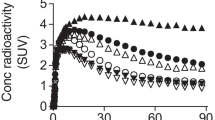Abstract
The in vivo labelling of 5-hydroxytryptamine (5-HT)1A receptors in the mouse brain was studied with the novel selective 5-HT1A receptor antagonist, NAD-299 ((R)-3-N,N-dicyclobutylamino-8-fluoro-3,4-dihydro-2H-1-benzopyran-5-carboxamide hydrogen (2R,3R)-tartrate monohydrate). 3H-NAD-299 was injected in a tail vein and the radioactivity in various brain regions was determined. More than 90% of the radioactivity in hippocampus, 15 min after the injection, was intact NAD-299. At this time the amount of 3H-NAD-299 was highest in hippocampus followed by frontal cortex, mesencephalon, hypothalamus, striatum and cerebellum. The specific accumulation of radioactivity (after subtracting cerebellum values) in frontal cortex and hippocampus was maximal 10 to 30 min after the injection and had almost disappeared after 2 h. Saturation kinetics derived Bmax (pmol/g wet weight tissue) values of 19.6±2.0 in frontal cortex and 38.0±3.5 in hippocampus. The apparent Kd values expressed in nmol/kg 3H-NAD-299 injected, were 12.3±2.2 in frontal cortex and 20.3±3.1 in hippocampus. The 5-HT1A receptor antagonist, WAY-100,635 competitively inhibited the specific accumulation of 3H-NAD-299 and was about equipotent with unlabelled NAD-299 with ED50 values of 20–30 nmol/kg s.c. These compounds were about 10 times more potent than the 5-HT1A receptor antagonists, p-MPPI and NDL-249 and 100 times more potent than (S)-UH-301. 5-HT1A receptor agonists, e.g. 8-OH-DPAT and flesinoxan and partial agonists, e.g. pindolol, buspirone and ipsapirone had low potency in this in vivo assay. Spiperone and methiothepin inhibited the 3H-NAD-299 accumulation at 10 μmol/kg s.c. The α1-adrenoceptor antagonist, prazosin at 2 μmol/kg s.c. increased significantly the specific accumulation of 3H-NAD-299. Pretreatment of the mice with the non-selective, irreversible receptor antagonist, EEDQ produced a dose related long-lasting decrease in the accumulation of 3H-NAD-299. It is concluded that NAD-299 is a very suitable ligand for studies of 5-HT1A receptors in the brain in vivo.
Similar content being viewed by others
Author information
Authors and Affiliations
Additional information
Received: 17 October 1997 / Accepted: 24 January 1998
Rights and permissions
About this article
Cite this article
Stenfors, C., Werner, T. & Ross, S. In vivo labelling of the mouse brain 5-hydroxytryptamine1A receptor with the novel selective antagonist 3H-NAD-299. Naunyn-Schmiedeberg's Arch Pharmacol 357, 500–507 (1998). https://doi.org/10.1007/PL00005199
Issue Date:
DOI: https://doi.org/10.1007/PL00005199




